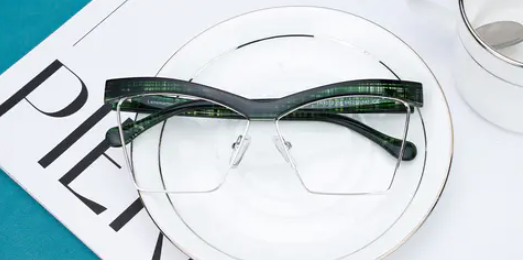In the eyewear sector, wherein developments come and go along with every passing season, there’s a tradition that stands aside with an air of secrecy of undying beauty: browline glasses. These unique frames have transcended decades, evolving from their modest beginnings to turning into cultural icons.
The Birth of Browline Glasses:
The history of browline glasses dates back to the late 1940s after they were added by Jack Rohrbach, a visionary clothier running for the Shuron Optical Company. These glasses marked an innovative departure from conventional eyewear by ingeniously combining plastic and metallic uniquely and elegantly. The layout’s most distinguishing characteristic turned into the upper part of the body, resembling an accentuated eyebrow line, which gave rise to their unique call.
The Mid-twentieth Century’s Fascination:
Browline glasses enjoyed their zenith of reputation in the 1950s and 1960s and hastily have become an emblem of intellectual prowess and sophistication. Many influential figures, from Malcolm X, who wore browline glasses with a cause and style, to actors like Cary Grant and James Dean, further cemented their reputation as a mark of favor and substance.
The key to browline glasses’ charm during this period turned into their unique layout, which presented an excellent marriage of form and characteristic. The sturdy plastic upper frame furnished sturdiness, while the decreased metallic frame maintained a swish and delicate look. This aesthetic preference positioned browline glasses as the perfect accessory for people demanding style and application.
Cultural Significance in the Sixties:
The 1960s turned into a decade of unheard-of social exchange and artistic innovation, and browline glasses played an imperative function in these cultural shifts. The Beatles, arguably one of the most influential bands in history, not only transformed the music scene but also left an indelible mark on the style arena, regularly donning these iconic frames. It contributed immensely to the full-size recognition of browline glasses.
Additionally, these glasses transcended track and fashion and determined their manner in literature and movies. Vladimir Nabokov’s controversial novel, “Lolita,” featured Humbert Humbert, an individual regarded for his intellectual depth, who is depicted wearing browline glasses. This preference symbolized Humbert’s complexity and highbrow intensity. In the identical period, the man or woman of Atticus Finch, portrayed with the aid of Gregory Peck in the timeless movie “To Kill a Mockingbird,” wore browline glasses. The individual’s know-how, ethical integrity, and unwavering commitment to justice are intently related to his preference for eyewear, similarly elevating the reputation of those glasses.
The Browline Resurgence within the Twenty-first Century:
While browline glasses skilled a dip in recognition during the 1980s, a top-notch revival of this classic eyewear happened in the 21st century. Several factors contributed to this resurgence, including a renewed fascination with unfashionable style and a surge in nostalgia-pushed trends. Furthermore, the impact of popular culture performed a pivotal position in the rejuvenation of browline glasses.
Contemporary Appeal:
Browline glasses have persisted to preserve their fame as a brand of undying beauty and refinement. Their appeal lies in their capacity to decorate numerous face shapes and patterns, ensuring their relevance inside the ever-evolving fashion landscape. Here are a few reasons at the back of their persevered reputation:
Versatile Design: Browline glasses have a versatility that permits them to transition seamlessly from formal to informal settings. This adaptability makes them a realistic preference for individuals navigating the multifaceted nature of modern life.
Flattering Shape: The top plastic body of browline glasses draws attention to the brow and eyes, enhancing numerous facial capabilities and accentuating the eyes flatteringly.
Retro Charm: The undeniable unfashionable allure of browline glasses appeals to a wide variety of people looking to make a unique fashion assertion in an era ruled by modern-day designs.
Gender-Neutral: Browline glasses inherently own a gender-impartial satisfaction, making them handy and appealing to human beings of all genders.
Variety of Colors and Materials: The tremendous variety of colors and materials permits wearers to specify their style and personality via eyewear efficiently.
Customization: Numerous eyewear brands now offer customization alternatives, permitting people to create a couple of browline glasses that reflect their specific tastes and alternatives.
Choosing the Perfect Pair:
Selecting a suitable pair of browline glasses requires face form awareness, non-public fashion consideration, and lifestyle evaluation. Here are some hints to help you make an informed choice when buying eyeglasses:
Face Shape: Different browline patterns can complement specific face shapes. For example, round faces have an advantage over angular or rectangular frames, even as people with rectangular faces locate rounded, more flattering designs.
Frame Material: Browline glasses are available in various substances, including acetate and metallic. Consider your consolation and lifestyle when choosing a cloth.
Color: Your glasses must complement your pores, skin tone, and private style. Classic black or tortoiseshell frames are flexible, even as bolder colorations could make an announcement.
Size: The length of the glasses should be proportionate to your face. Ensure that they take a seat without difficulty for your nostril without sliding down.
Lens Type: Depending on your vision desires, you can pick out prescription lenses, transition lenses, or non-prescription clear lenses to attain a fashion-forward appearance.
Browline glasses have continually verified their enduring attraction, transitioning from an image of intellectualism inside the mid-twentieth century to a timeless style announcement within the twenty-first century. Their seamless mixture of style, capability, and versatility has made them preferred for individuals of all ages and backgrounds.

Founder/CEO
Brian formed Living By Examplealongside Cynthia after working for two decades alongside international institutions for humanitarian aids and other efforts worldwide, may it be catastrophes made by men or nature. Brian built Living By Examplewith the hopes of bringing more cultural diversity across the internet.
He primarily writes amazing stories about cultures and shares different ideals with our readers through his stories. He believes that people empowerment is important especially during these trying times.






